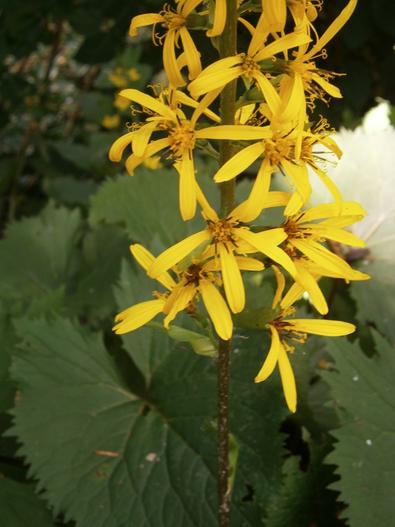Przewalski’s Leopard Plant
(Ligularia przewalskii)
Przewalski’s Leopard Plant (Ligularia przewalskii)
/
/

Meneerke bloem
CC BY-SA 3.0
Image By:
Meneerke bloem
Recorded By:
Copyright:
CC BY-SA 3.0
Copyright Notice:
Photo by: Meneerke bloem | License Type: CC BY-SA 3.0 | License URL: https://creativecommons.org/licenses/by-sa/3.0 | Uploader: Meneerke bloem | Publisher: Wikipedia Commons


























Estimated Native Range
Summary
Ligularia przewalskii, commonly known as Przewalski’s Leopard Plant, is a deciduous perennial herb that is native to moist meadows and stream banks in North and Central Asia, particularly in regions like Siberia and China. It can reach a height of 4-6 feet (1.2-1.8 meters) and a width of 2-3 feet (0.6-0.9 meters). The plant features large, deeply cut, dark green foliage that adds texture to garden spaces. Its tall spike-like inflorescences bear bright yellow composite flowers that are highly showy, blooming from July to August and attracting pollinators.
Przewalski’s Leopard Plant is valued for its striking foliage and vibrant yellow flowers, which make it a focal point in shade gardens, woodland plantings, and borders. It thrives in cool, moist conditions and is best suited for part shade to full shade environments. The plant prefers consistently moist soil with good drainage and can tolerate soils with slow or medium drainage. While it requires medium to high amounts of water, it is important to avoid waterlogged conditions. It is susceptible to wilting in hot, sunny locations, so it should be sheltered from the afternoon sun. Propagation is typically done by seed or by dividing the crowns in the spring or fall.CC BY-SA 4.0
Przewalski’s Leopard Plant is valued for its striking foliage and vibrant yellow flowers, which make it a focal point in shade gardens, woodland plantings, and borders. It thrives in cool, moist conditions and is best suited for part shade to full shade environments. The plant prefers consistently moist soil with good drainage and can tolerate soils with slow or medium drainage. While it requires medium to high amounts of water, it is important to avoid waterlogged conditions. It is susceptible to wilting in hot, sunny locations, so it should be sheltered from the afternoon sun. Propagation is typically done by seed or by dividing the crowns in the spring or fall.CC BY-SA 4.0
Plant Description
- Plant Type: Herb
- Height: 4-6 feet
- Width: 2-3 feet
- Growth Rate: Moderate
- Flower Color: Yellow
- Flowering Season: Summer
- Leaf Retention: Deciduous
Growth Requirements
- Sun: Part Shade, Full Shade
- Water: Medium, High
- Drainage: Slow, Medium
Common Uses
Bee Garden, Bird Garden, Butterfly Garden, Deer Resistant, Hummingbird Garden, Showy Flowers
Natural Habitat
Moist meadows and stream banks in North and Central Asia
Other Names
Common Names: Przewalski’s Golden Ray, Spirstånds
Scientific Names: , Ligularia przewalskii, Senecio przewalskii, Senecillis przewalskii,
GBIF Accepted Name: Ligularia przewalskii (Maxim.) Diels